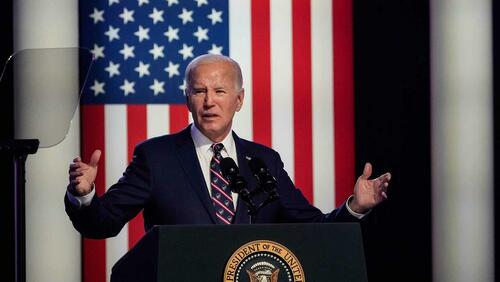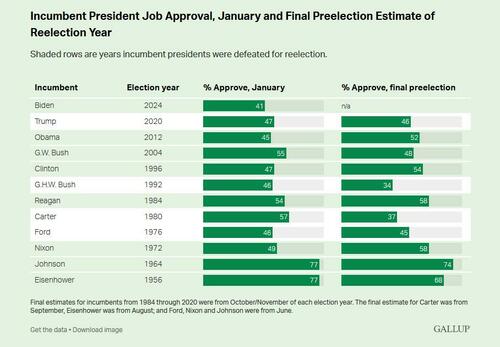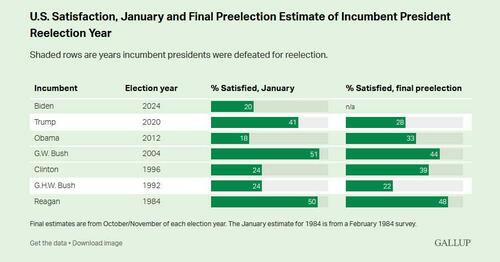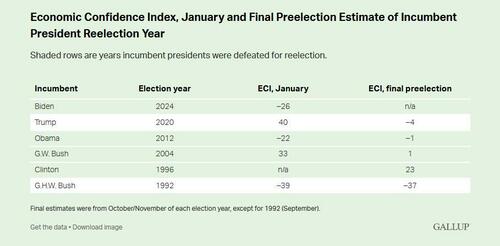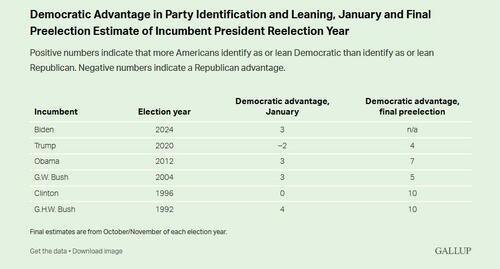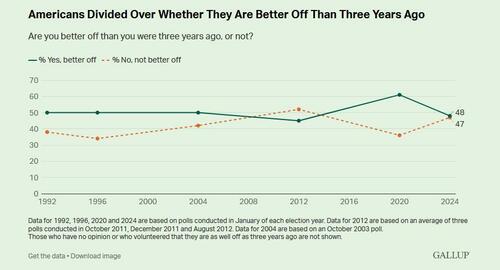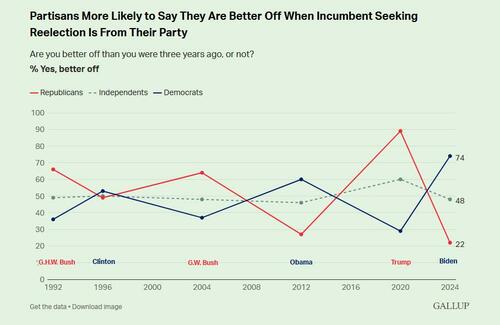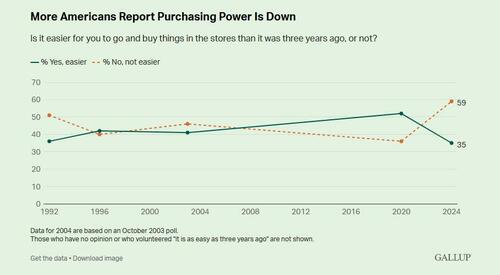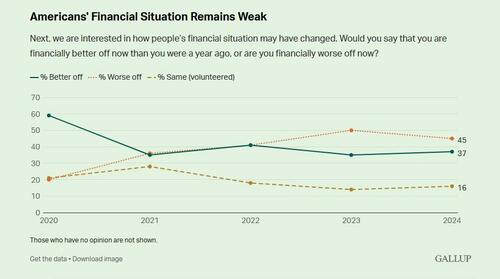“Biden Reelection Chances Do Not Look Favorable”: Political, Economic Indicators “Not Promising”, Gallup Finds
By Jeffrey Jones and Megan Brennan of Gallup
Several key indicators of the 2024 election environment indicate that President Joe Biden faces an uphill climb to win a second term. His job approval rating, Americans’ satisfaction with how things are going in the country and their confidence in the economy are below the levels associated with successful reelection bids in recent elections.
While Democrats hold a slight edge in national party identification and partisan leanings, that advantage is smaller than what it has been in past presidential elections won by Democratic incumbents.
In less direct measures of the electoral environment, Americans are more inclined to say that they are worse off financially, that it is harder to buy things and that the U.S. is as respected throughout the world as it was before Biden took office.
Biden’s fate will ultimately be determined by whether Americans’ views on these metrics improve over the course of the year (as they did for Bill Clinton in 1996 and Barack Obama in 2012), stay the same or get worse (as they did for George H.W. Bush in 1992 and Donald Trump in 2020).
Presidential Job Approval
Incumbent job approval is arguably the best predictor of reelection success. Presidents with approval ratings of 50% or higher close to Election Day have all been reelected. All but one president with a sub-50% approval rating lost, the exception being George W. Bush. He won reelection with a 48% approval rating in Gallup’s final 2004 preelection poll taken in late October. However, he registered multiple 50% readings earlier in the month and had a 51% approval rating among likely voters in that final survey.
Among the approval ratings that did not carry incumbents to victory, Trump’s 46% approval rating is the highest and Gerald Ford’s 45% is close behind. The inauspicious ratings descend from there, all the way down to 34% for George H.W. Bush.
Biden’s 41% job approval rating, the lowest among incumbents in January of an election year, puts him in a precarious spot. It has not been unusual for incumbents to be below the 50% threshold this early on. But Biden’s reelection may depend on his ability to boost his numbers close to that threshold, something Clinton, Obama and Richard Nixon were able to do but Trump and Ford were not. Other presidents, including George W. Bush, George H.W. Bush and Jimmy Carter, saw significant declines in approval during their fourth year in office.
Satisfaction With the State of the Nation
Over the past four decades, incumbent presidents have still been reelected when majorities of Americans are dissatisfied with the way things are going in the country, but the cutoff seems to be 30% satisfaction. Less than 30% of U.S. adults were satisfied at the time of the 1992 and 2020 elections when the elder Bush and Trump lost, whereas more than 30% were satisfied in the years incumbents won.
Biden started 2024 with 20% of Americans satisfied with the country’s direction. Obama and Clinton had similar marks in January of their reelection years but saw satisfaction increase as the year wore on. For Trump, the opposite was the case, as the relatively high 41% satisfaction in January 2020 was soon dashed by the coronavirus pandemic and the resulting economic downturn, as well as racial strife associated with the George Floyd killing.
Economic Evaluations
Although the economy is always a key issue in presidential election campaigns, Americans’ confidence in the economy is not always determinative of election outcomes. Gallup has computed its Economic Confidence Index in five presidential election years since 1992 when an incumbent sought reelection. The index summarizes Americans’ assessments of current national economic conditions and their perceptions of whether the economy is getting better or worse. Positive scores indicate economic optimism, and negative scores indicate pessimism, with a minimum theoretical score of -100 and a maximum of +100.
Among the past five incumbent elections, Americans were decidedly positive about the economy in one — 1996, when Clinton was reelected — and decidedly negative in one — 1992, when George H.W. Bush was defeated. In 2004, 2012 and 2020, index scores were close to the scale’s zero midpoint, indicating neither positive nor negative views of the economy. In two of those elections (2004 and 2012), the incumbent prevailed, but in 2020, Trump lost, likely because the coronavirus pandemic overshadowed the economy as an issue.
Currently, Americans’ economic confidence is closer to that of 1992 than other incumbent election years. However, the index has been improving in recent months. Biden can hope that economic perceptions follow a similar trajectory to 2012. That year, confidence started more negative than positive but approached a more neutral rating by the election, which Obama won.
Party Identification and Leaning
Americans’ partisanship strongly aligns with how they will vote and is thus an important indicator of election outcomes. Democrats typically lead Republicans in Americans’ party preferences; therefore, the size of that lead indicates whether Democrats are in a strong or weak position.
Gallup’s January 2024 poll shows the Democratic Party with a three-point advantage over Republicans: 46% identify as or lean Democratic, and 43% identify as or lean Republican. If this were October, these figures would be concerning for Biden, as it would represent the smallest Democratic advantage in an incumbent election year, including 2004 when Republican George W. Bush won with Democrats holding a five-point edge. In years Democratic incumbents won (1996 and 2012), the Democrats’ party advantage was +10 and +7, respectively.
A possible silver lining for the Biden campaign is that Democrats’ party advantage has often increased between January and October or November of an election year. This has occurred in all election years featuring an incumbent since 1992.
While Democratic Party identification and leaning have increased in each of the past five election years involving an incumbent, that pattern has not occurred in other recent elections. In non-incumbent years, Democrats increased their advantage in one (2000), saw no change in another (2016) and saw it shrink in one (2008).
Better Off Than Three Years Ago
Americans are evenly divided in their assessments of whether they are better off now than they were three years ago, with 48% saying they are and 47% saying they are not.
Gallup has asked this question in the early stages of previous election campaigns when incumbents were running for reelection. The current share of U.S. adults who say they are better off now is down from 2020’s pre-pandemic reading, but it is similar to the readings in prior election cycles. In 1992, 1996 and 2003, more Americans said they were better off, and two of the three presidents won reelection. In 2012, slightly more said they were not better off, but Obama still won another term.
Americans’ perceptions of whether they are personally better off now than three years ago are largely influenced by their party leanings and, to a lesser extent, their income level. There is currently a wide gulf between Democrats’ (74%) and Republicans’ (22%) assessments of whether they are better off than three years ago, and independents are squarely in the middle of the two groups, at 48%.
This is the fifth election cycle of the past six that partisans in the same party as the sitting president seeking reelection are significantly more likely than their counterparts to say they are better off. The gaps in partisans’ reports since 1992 have ranged from four points in 1996 when Clinton ran for a second term to 60 points in 2020 when Trump ran. The current 52-point gap is the second highest.
Meanwhile, 53% of those in upper-income households and 50% in middle-income households say they are better off, compared with 41% in lower-income households.
The “better off than three years ago” question is typically only asked early in election campaigns. Near the end of prior campaigns, Gallup has asked Americans whether they were better off than four years ago. That question has not shown an obvious relationship to election outcomes, exemplified by the high scores in the 2020 election that Trump eventually lost and weaker scores in Reagan’s 1984 landslide.
Personal Finances
While the current U.S. inflation rate is far below its 9.1% recent peak in June 2022, it is about twice what it was in November 2020, and many Americans continue to struggle because of high prices. Only 35% of U.S. adults say it is easier to buy things at stores than it was three years ago, while 59% say it is not.
The share of Americans who currently say shopping is not easier is higher than in 1992, 1996, 2003 and 2020. The question was not asked in other presidential election cycles and is not asked at the end of campaigns.
The previous reading from January 2020, before the COVID-19 pandemic forced widespread shutdowns, showed a slim 52% majority saying it was easier for them to make purchases than three years ago, and 36% said it was not.
Americans’ reports of their own financial situation are also more negative now than in early 2020. Currently, 37% of U.S. adults say they are financially better off than a year ago, 45% say they are worse off, and 16% volunteer that they are the same. These readings are similar to last year’s but sharply different from the last election year, 2020, when 59% reported being better off and 20% worse off.
Looking ahead, a steady 61% majority of Americans think they will be financially better off in a year, but this is lower than the 74% who said the same in 2020.
Readings on these personal finance measures differ significantly by party identification, with Democrats much more positive than Republicans. Democrats (58%) are more than four times as likely as Republicans (14%) to say buying things is easier than it was three years ago. Similarly, Democrats (57%) are nearly three times as likely as their Republican counterparts (20%) to say their personal financial situation is better now than three years ago. Independents’ views on both are closer to Republicans’, as 33% say shopping is easier and 35% report an improvement in their financial situation.
There is no significant difference by household income level in views of buying power, as majorities across income groups say it is not easier to shop. However, lower-income (32%) and middle-income households (36%) are less likely than upper-income households (47%) to say their personal financial situation is better than one year ago.
U.S. International Respect
When it comes to foreign policy, only about one-quarter of Americans, 27%, think the U.S. is as respected throughout the world as it was three years ago, while 67% say it is not. Just 3% volunteer that it is more respected now. Americans were similarly pessimistic about the United States’ international standing in past election years, with no more than 40% (in 1992 and 2000) believing respect for the U.S. remained intact. The current reading is identical to 2003 and similar to 2012 (30%).
The U.S. has had varying degrees of involvement in world affairs over the past three years, ranging from its military departure from Afghanistan in 2021, its support for Ukraine in the Russia-Ukraine war, and its military support for Israel following the October 2023 Hamas invasion of Israel, which resulted in an Israeli military operation in Gaza. Both the Russia-Ukraine and Hamas-Israeli wars are ongoing, and Americans are sharply divided over the proper U.S. role in each.
Democrats are split in their view of whether the U.S. is as respected around the world as it was three years ago, with 47% saying it is and 44% saying it is not. At the same time, 7% of Republicans think the U.S. is as respected, and 91% think it is not. Independents fall in between the partisan groups, with 27% saying it is respected and 67% saying it is not.
Bottom Line
Biden’s reelection chances do not look very favorable in early 2024. His job approval rating is lower than all recent incumbents at the same point, including those who ultimately lost the election, and key national mood indicators are more in line with those for past losers than winners. Party identification offers Biden some hope but depends on Democrats making gains rather than holding steady in national support, something that has happened at least slightly in each of the past five incumbent elections.
Biden’s chances may rest on him experiencing a comeback similar to what Obama achieved in 2012 when Biden was serving as vice president. That year, national mood indicators and Obama’s job approval rating significantly improved during the campaign, and the president was elected to a second term. Unlike Obama, though, Biden also faces questions about his age and ability to carry out his duties in a second term. Biden is also starting at a lower point in job approval than Obama did, meaning he has to show a bigger improvement.
Biden won his first term after national mood indicators worsened throughout the 2020 election year, which led to his defeating Trump, the incumbent.
Many Americans continue to struggle financially, and Biden has so far been unable to convince voters of the economy’s health or his accomplishments. If he cannot do so by the summer, particularly before the Democratic National Convention, his chances of winning reelection will grow increasingly bleak.
Tyler Durden
Fri, 02/16/2024 – 20:20
via ZeroHedge News https://ift.tt/Ucsf1F5 Tyler Durden
